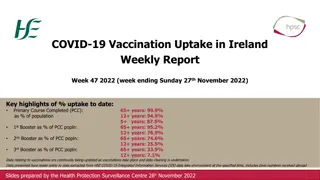Week Fourteen Agenda
Here, we delve into the essentials of Wireless NICs and Access Points, crucial components for seamless network connectivity. Explore how Wireless NICs enable devices to send and receive RF signals, while Access Points bridge wireless clients to the wired LAN. Gain insights into WLAN operations and the coverage area of Access Points to enhance your comprehension of network architecture.
Uploaded on Feb 20, 2025 | 0 Views
Download Presentation

Please find below an Image/Link to download the presentation.
The content on the website is provided AS IS for your information and personal use only. It may not be sold, licensed, or shared on other websites without obtaining consent from the author.If you encounter any issues during the download, it is possible that the publisher has removed the file from their server.
You are allowed to download the files provided on this website for personal or commercial use, subject to the condition that they are used lawfully. All files are the property of their respective owners.
The content on the website is provided AS IS for your information and personal use only. It may not be sold, licensed, or shared on other websites without obtaining consent from the author.
E N D
Presentation Transcript
Week Fourteen Agenda Student Gradebook Are there any assignments that have not been graded? Announcements Administration of the final exam will also be at the Student Learning Center. Final exam review link is available If you experience problems taking the final exam, call me immediately at 614.519.5853. Your final exam status will be posted on the course web page in the folder named, Final Exam Status.
Week Fourteen Agenda Current Week Information Wireless NIC s Access Point Coverage Area LAN Security Designing WLANs
Final Exam Composition True/False questions: 80 (1 point) Multiple choice questions: 20 (2 point) Essay questions: 6 questions (5 points) Total points: 150
Wireless NICs The device that makes a client station capable of sending and receiving RF signals is the wireless NIC. Like an Ethernet NIC, the wireless NIC, uses the modulation technique it is configured to use, encodes a data stream onto an RF signal. Wireless NICs are most often associated with mobile devices, such as laptop computers. In the 1990s , wireless NICs for laptops were cards that slipped into the PCMCIA slot. PCMCIA wireless NICs are still available, but manufacturers build the wireless NIC right into the laptop.
Wireless NICs Unlike IEEE 802.3 standard Ethernet interfaces built into PCs, the wireless NIC is not visible, because there is no requirement to connect a cable to it.
What is a Wireless Access Point (AP) An access point connects wireless clients (or stations) to the wired LAN. An access point is a Layer 2 device that functions like an IEEE 802.3 Ethernet hub. Client devices do not typically communicate directly with each other; they communicate with the AP. In essence, an access point converts the TCP/IP data packets from their IEEE 802.11 frame encapsulation format in the air to the IEEE 802.3 Ethernet frame format on the wired Ethernet network.
WLAN Operation The coverage area of an AP is called the Basic Service Set (BSS). Otherwise known as a cell. A Service Set Identifier (SSID) is a wireless network name transmitted by the WLAN. Roaming occurs when a wireless client moves from one AP area to another. Basically, moving from one cell to another cell within the same SSID.
Communication Security Authentication: Only legitimate clients are allowed to access the network via trusted APs. Encryption: Securing the confidentiality of transmitted data. Encryption is a piece of technology that works by scrambling data so it is unreadable by unintended parties. Triple DES - Replaced Data Encryption Standard. Triple DES uses three individual keys with 56 bits each. The total key length adds up to 168 bits. RSA - RSA is a public-key encryption algorithm and the standard for encrypting data sent over the internet.
WLAN Security Blowfish - This symmetric cipher splits messages into blocks of 64 bits and encrypts them individually. Twofish - Keys used in this algorithm may be up to 256 bits in length and as a symmetric technique, only one key is needed. AES - Although it is extremely efficient in 128-bit form, AES also uses keys of 192 and 256 bits for heavy duty encryption purposes. AES is largely considered impervious to all attacks, with the exception of brute force, which attempts to decipher messages using all possible combinations in the 128, 192, or 256-bit cipher. Still, security experts believe that AES will eventually be hailed the de facto standard for encrypting data in the private sector. Intrusion detection and intrusion protection: Monitors, detects, and reduces unauthorized access and attacks against the network.
WLAN Security Intrusion detection and intrusion protection: Cisco security researchers recently found that malicious traffic was visible on 100% of the networks sampled for the Cisco Midyear Security Report. Worse, the breaches were entirely undetected. The moral of the story? Traditional security measures no longer work. It s next-gen time.
Wireless Network Technologies Personal-area network (PAN): A persons personal workspace. Local-area network (WLAN): A network design to be enterprise-based network that allows the use of complete suites of enterprise applications, without wires. Metropolitan-area network (MAN): Deployed inside a metropolitan area, allowing wireless connectivity throughout an urban area. Wide-area network (WAN): A wider but slower area of coverage, such as rural areas.
Autonomous Access Point Originally, WLANs were all the same configuration and management at each access point. This type of access point was considered a stand-alone device. The term referring to the stand-alone device was a fat AP, or most commonly called today, an autonomous AP. All encryption and decryption mechanisms and MAC layer mechanisms also operate within the autonomous AP.
Autonomous Access Point Autonomous AP require power in usually non- traditional places. Two solutions: 1. Power of Ethernet (PoE) and power injectors. This power is inline with the Ethernet port, over the Category 5 cable. 2. Mid-span power injectors is a stand-alone unit, positioned into the LAN between the Ethernet switch and the device requiring power.
Autonomous Access Point IEEE 802.1X Standard is used for wireless client authentication, dynamic encryption keys can be distributed to each user each time that user authenticates on the network. Wi-Fi Alliance also introduced Wi-Fi Protection Access (WPA) to enhance encryption and protect against all known Wired Equivalent Privacy (WEP) key vulnerabilities. The Wi-Fi Alliance interoperable implementation of IEEE 802.11i with AES is called WPA2.
Autonomous Access Point translational bridge and is responsible for putting the wireless client RF traffic into the appropriate local VLAN on the wired network. The autonomous AP acts as an IEEE 802.1Q
Designing a Wireless Network in a wireless network design, and the process to conduct such a survey. It is the first step in the design and deployment of a wireless network and the one to insure desired operation. An RF Site Survey is used for many reasons
Designing a Wireless Network The RF Site Survey is used to study the following facility areas: To understand the RF characteristics in the environment. Plans and reviews RF coverage areas. Check for RF interference. Determine the appropriate placement of wireless infrastructure devices.
Designing a Wireless Network the RF signal from reaching many parts of the facility. To address these issues, weak signal strength regions must be addressed and identified. In a wireless network, issues could prevent
Designing a Wireless Network RF Site Survey Process 1.Define customer requirements number and types to support devices. 2.Identify coverage areas and user density facility diagram, and do a visual inspection. 3.Determine preliminary AP locations existing power, cabling, cell coverage and overlap. 4.Perform the actual survey of the actual AP locations after installation. 5.Document the findings record device locations and signal readings (baseline).
Designing a Wireless Network and visualize anticipated WLAN behavior for planning and fast rollout. A heat map diagrammatically represents signal strength. The warmer the color, the stronger the signal. Use of a Graphical heat map helps identify
Designing a Wireless Network Graphical Heat map
Designing a Wireless Network Stony Brook s outdoor wireless network map
Security Issues Early networks were not designed for security as all users were trusted and the network was not international. Modern network security requirements include the following: Prevent external hackers from getting access to the network. Allow only authorized users into the network. Prevent those inside the network from executing deliberate or inadvertent attacks. Provide different levels of access for different types of users. Protect data from misuse and corruption. Comply with security legislation, industry standards, and company policies.
Legislation and Security The U.S. Gramm-Leach-Bliley Act of 1999 (GLBA) provides limited privacy protections against the sale of private financial information and codifies protections against pretexting (concealing). The U.S. Health Insurance Portability and Accountability Act (HIPAA) to enable better access to health insurance, reduce fraud and abuse, and lower the overall cost of health care in the United States. European Union data protection Directive 95/46/EC requires that European Union member states protect people's privacy rights when processing personal data, and that the flow of personal data between member states must not be restricted or prohibited because of these privacy rights.
Legislation and Security The U.S. Sarbanes-Oxley Act of 2002 (SOX) establishes new or enhanced auditing and financial standards for all U.S. public company boards, management, and public accounting firms. Payment Card Industry (PCI) Data Security Standard (DSS) developed to ensure safe handling of sensitive payment information. The Canadian Personal Information Protection and Electronic Documents Act (PIPEDA): establishes rules for managing personal information by organizations involved in commercial activities.
Security Terminology Virus A program that triggers a damaging outcome to a computer and/or network. Trojan horse Pretends to be an inoffensive application when in fact it might contain a destructive payload. SPAM Unsolicited or unwanted email that may contain viruses or links to compromised web sites. Spyware A program that gathers information without the user's knowledge or consent and sends it back to the hacker.
Security Terminology Phishing Emails that try to convince the victim to release personal information. Email appears to come from a legitimate source directs the victim to website that looks legitimate. Spear phishing Very targeted phishing attack may seem to come from a bank or IRS or from a creditable source to gain access to accounts.
Security Terminology Social engineering The practice of obtaining confidential information by manipulating legitimate users. Examples include the following: Getting physical access: A hacker might get confidential information and passwords by having physical access to the organization. For example, the hacker might visit an organization and see passwords that are insecurely posted in an office or cubicle. Using a psychological approach: A hacker might exploit human nature to obtain access to confidential information. For example, a hacker might send an email or call and ask for passwords, pretending that the information is required to maintain the victim's account.
Threats Reconnaissance: The active gathering of information about an enemy or target to learn as much as possible about the target and the involved systems. Usually the prelude to an attack against a particular target. Gaining unauthorized system access: The next step after reconnaissance gaining access to the system by exploiting the system or using social engineering techniques. Denial of service (DoS): Does not require direct access to a system is used to make systems unusable by overloading their resources such as CPU or network bandwidth. Multiple sources conduct DoS attacks, which are called a Distributed DoS (DDoS) attack.
Targets of Reconnaissance Attacks Active targets (hosts/devices currently communicating on the network). Network services that are running continuously. Operating system platforms that are not secured. Trust relationships rather than objective software or hardware defenses. File and directory permissions not set properly. User account information not secured properly.
Threat: Gaining Unauthorized Access to Systems Use of usernames and passwords by unauthorized persons
DoS Threat DoS attacks are aggressive attacks on an individual computer or groups of computers with the intent to deny services to intended users. DoS attacks can target end user systems, servers, routers, and network links. Video on DoS. https://www.youtube.com/watch?v=0VutW15 kEZM
Mitigate DoS Attack What is Cisco DHCP Snooping? DHCP snooping is a security feature that acts like a firewall between untrusted hosts and trusted DHCP servers. The DHCP snooping feature performs the following activities: Validates DHCP messages received from untrusted sources and filters out invalid messages. Rate-limits DHCP traffic from trusted and untrusted sources. Builds and maintains the DHCP snooping binding database, which contains information about untrusted hosts with leased IP addresses. Utilizes the DHCP snooping binding database to validate subsequent requests from untrusted hosts.
Mitigate DoS Attack Use Cisco DHCP Snooping to verify DHCP transactions and protect against rogue DHCP servers. DHCP Snooping filters DHCP packets. Use Dynamic Address Resolution Protocol (ARP) Inspection (DAI) to intercept all ARP requests and replies on untrusted interfaces (ports). Implement unicast reverse path forwarding checks to verify if the source IP address is reachable so that packets from malformed or forged source IP addresses are prevented from entering the network. Implement access control lists (ACL) to filter traffic. Rate-limit traffic such as incoming ARP and DHCP requests.
Port Scanners Network Mapper (Nmap): Nmap is a free open-source utility for network exploration or security auditing. It was designed to rapidly scan large networks; it also maps single hosts. NetStumbler: Net Stumbler is a tool for Microsoft Windows that facilitates detection of WLANs using the IEEE 802.11b, 802.11a, and 802.11g WLAN standards. A trimmed-down version of the tool called MiniStumbler is available for Windows. SuperScan: Super Scan is a popular Windows port- scanning tool with high scanning speed, host detection, extensive banner grabbing, and Windows host enumeration capability.
Port Scanners (cont) Kismet: Kismet is an IEEE 802.11 Layer 2 wireless network detector, sniffer, and IDS that can sniff IEEE 802.11b, 802.11a, and 802.11g traffic. It identifies networks by passively collecting packets and detecting standard named networks, detecting hidden networks, and inferring the presence of non-beaconing networks (networks that do not advertise themselves) via data traffic.
Vulnerability Scanners Nessus: Nessus is an open-source product designed to automate the testing and discovery of known security problems. A Windows graphical front end is available, although the core Nessus product requires Linux or UNIX to run. Microsoft Baseline Security Analyzer (MBSA): Although it s not a true vulnerability scanner, companies that rely primarily on Microsoft Windows products can use the freely available MBSA. MBSA scans the system and identifies whether any patches are missing for products such as the Windows operating systems, Internet Information Server, SQL Server, Exchange Server, Internet Explorer, Windows Media Player, and Microsoft Office products. MBSA also identifies missing or weak passwords and other common security issues.
Vulnerability Scanners Security Administrator s Integrated Network Tool (SAINT): SAINT is a commercial vulnerability assessment tool that runs exclusively on UNIX.
Risks Confidentiality of data: Ensures that only authorized users can view sensitive information. Prevents theft, legal liabilities, and damage to the organization. Integrity of data: Ensures that only authorized users can change sensitive information. Guarantees the authenticity of data. System and data availability: Ensures uninterrupted access to important computing resources. Prevents business disruption and loss of productivity.
Risks of Integrity Violations and Confidentiality Breaches Integrity violations can occur when an attacker attempts to change sensitive data without proper authorization. Confidentiality breaches can occur when an attacker attempts to read sensitive data without proper authorization. Confidentiality attacks can be extremely difficult to detect because the attacker can copy sensitive data without the owner s knowledge and without leaving a trace.
Mitigation Limit access to network resources using network access control, such as physical separation of networks, restrictive firewalls, and VLANs. Limit access to files and objects using operating system-based access controls, such as UNIX host security and Windows domain security and SNMP Firewall and SNMP. Limit user access to data by using application- level controls, such as different user profiles for different roles.
Mitigation Use cryptography to protect data outside the application. Examples include encryption to provide confidentiality, and secure fingerprints or digital signatures to provide data authenticity and integrity.
Considerations Business needs: What the organization wants to do with the network. Risk analysis: The risk-versus-cost balance. Security policy: The policies, standards, and guidelines that address business needs and risk. Industry-recommended practices: The reliable, well- understood, and recommended security practices in the industry. Security operations: The process for incident response, monitoring, maintenance, and compliance auditing of the system.
Network Security Policy What is a Network Security Policy? It is a broad, end-to-end document designed to be clearly applicable to an organization's operations. The policy is used to aid in network design, convey security principles, and facilitate network deployments. It is a complex document meant to govern items such as data access, web browsing, password usage, encryption, and email attachments.
Network Security Policy What is in the Network Security Policy? The network security policy outlines rules for network access, determines how policies are enforced, and describes the basic architecture of the organization's network security environment. The network security policy outlines what assets need to be protected and gives guidance on how it should be protected. Because of its breadth of coverage and impact, it is usually compiled by a committee.























